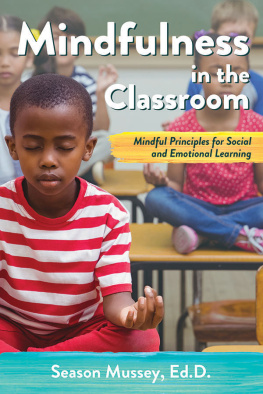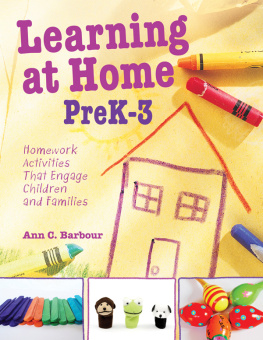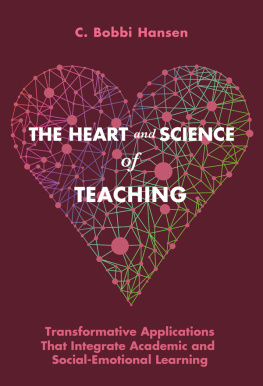Contents
Getting to the Heart of Learning
Social-Emotional Skills across the Early Childhood Curriculum
Ellen Booth Church
Photography courtesy of Shutterstock Photography 2014,
www.shutterstock.com.
Gryphon House, Inc.
Lewisville, NC
Copyright
2015 Ellen Booth Church
Published by Gryphon House, Inc.
P. O. Box 10, Lewisville, NC 27023
800.638.0928; 877.638.7576 (fax)
Visit us on the web at www.gryphonhouse.com.
All rights reserved. No part of this publication may be reproduced or transmitted in any form or by any means, electronic or technical, including photocopy, recording, or any information storage or retrieval system, without prior written permission of the publisher. Printed in the United States. Every effort has been made to locate copyright and permission information.
Cover photograph courtesy of Shutterstock.com, 2014.
Library of Congress Cataloging-in-Publication Data
Church, Ellen Booth.
Getting to the heart of learning : social-emotional skills across the early childhood curriculum / by Ellen Booth Church.
pages cm
Includes bibliographical references and index.
ISBN 978-0-87659-580-0 (alk. paper)
1. Early childhood education--Activity programs. 2. Social learning.
3. Emotional intelligence. 4. Education--Social aspects. I. Title.
LB1139.35.A37C476 2014
372.21--dc23
2014022750
Dedication
To my parents and first teachers, Francesca and Norval Church. They taught me not to just teach a subject but to teach the child.
Bulk Purchase
Gryphon House books are available for special premiums and sales promotions as well as for fund-raising use. Special editions or book excerpts also can be created to specifications. For details, contact the Director of Marketing at Gryphon House.
Disclaimer
Gryphon House, Inc., cannot be held responsible for damage, mishap, or injury incurred during the use of or because of activities in this book. Appropriate and reasonable caution and adult supervision of children involved in activities and corresponding to the age and capability of each child involved are recommended at all times. Do not leave children unattended at any time. Observe safety and caution at all times.
Introduction
I think, at a childs birth, if a mother could ask
a fairy godmother
to endow it with
the most useful gift,
that gift should be curiosity.
Eleanor Roosevelt,
first lady of the United States, author, and politician
All learning is social-emotional learning. Children do not learn skills in isolation but through social connection and interconnection to the real worldtheir world. It is their curiosity about the world that stimulates their desire to learn and to share what they have learned. We all learn best when we care about what we are learning and whom we are learning it with. Children live their lives with their hearts and minds open and connected. From that union of heart and mind, they develop into people who are balanced, happy, and successful.
Take a quick look at what is being presented in the news, and you will see the need in our culture for social-emotional development. Preschool and kindergarten teachers recognize both the need to address social development in their students and with their students families and the need to teach the basic skills that are essential to learning. These two things do not need to be separate; in fact, they truly are inseparable. Perhaps the trick is to recognize the connection and emphasize it in our interactions with children. It is one thing to know a concept and another to apply it to everyday life.
How to Use This Book
Each sectionmath, science, language, literacy, and motor skillsis designed to offer easy and interesting ways for the children to explore and develop their understandings. The activities list the subject-area skills the children will be learning, as well as the social-emotional skills that they will develop as they work together.
Lets Get Involved: Begin a new topic with engaging circle-time activities. Introduce the concepts that you will explore, and get the children involved and interested. Group involvement builds social skills while creating a broader experience.
Lets Explore Together: Broaden and deepen their explorations with activities designed to lead them to new discoveries. The activities can be done in centers or as large-group explorations and encourage teamwork, communication, sharing, listening, and other social-emotional skills that support childrens success in the classroom and beyond.
Learning Extensions and Building Community: Learning is an ongoing process that deepens when children revisit a concept in many different ways. This section provides activities that expand the learning both inside and outside the classroom. Playground and home activities help the children see how to apply the learning to the world around them. Family involvement helps children apply the social skills they are learning in school to their family relationships. And, activities with writing, art, music, and movement help children see the arts in all learning.
This book is much more than an activity book. It connects the reader both to curriculum content and to the deeper meaning of shared activities. Each activity is designed for building academic skills and social-emotional learning. Please join me as we explore some basic understandings and then dive into fun and learning that will create community as well as knowledge.
Chapter 1:
All Learning Is Social-Emotional Learning

Social and emotional learning starts with you. Our own self-awareness is one of the most important ways we can assist children as they grow and learn socially and emotionally. By exploring your own feelings and approaches, you develop an understanding that can help you see how you view and respond to children. Take a few minutes to ask yourself some questions. You might want to explore a question a day. Write your thoughts in a notebook or journal, and revisit them throughout the year.
How did I feel about school as a young child?
What was my social style in preschool and kindergarten?
What were my social challenges and successes in the early years?
How can I use these memories to build awareness about the children I teach?
As a teacher, how do I feel about going to school most days?
What are the challenges of working with young children?
What are the gifts of working with young children?
How do I feel my group functions as a community?
What do I do to build strong and meaningful relationships with my students?
Do I listen and acknowledge feelings?
Do I create an environment of trust and support that encourages children to share their feelings? How do I motivate children to solve their own problems?
Does the classroom environment support individual styles and positive social behaviors?
How much do we laugh and smile in our class?
Defining Social-Emotional Learning
If you take a look at recent writings about schools and programs, you will see these three letters: SEL. But what is SEL? Why is it so important? SEL is social-emotional learning. Social-emotional learning can be described as the development of the skills children need to understand and manage emotions, become self-aware and self-regulated, develop an understanding of others, create positive relationships, and problem solve.








